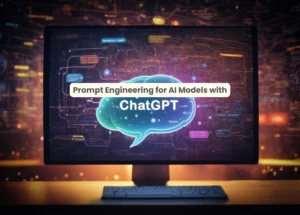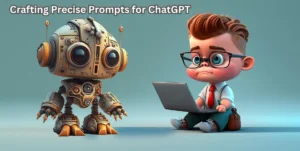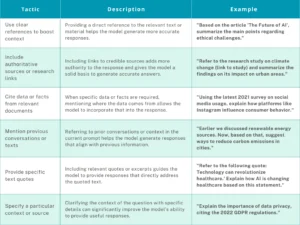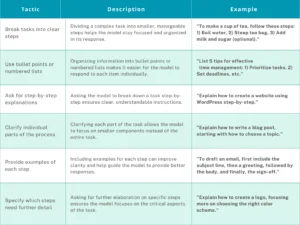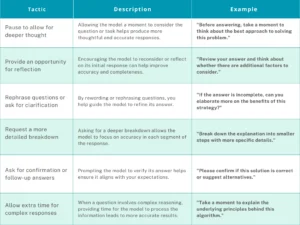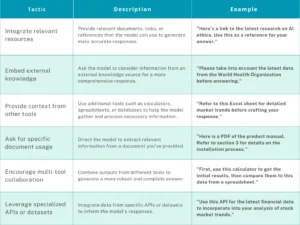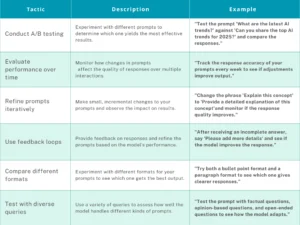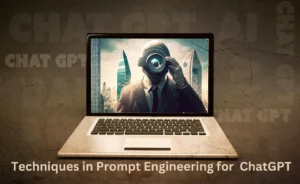In today’s AI-driven world, mastering Prompt Engineering for AI Models with ChatGPT is an essential skill. This practice, often referred to as Prompt Engineering with ChatGPT, serves as the foundation for unlocking the model’s full potential. But why does this matter? A well-thought-out prompt can generate accurate, insightful, and creative responses, while a poorly designed one may result in irrelevant or unclear outputs.
This article covers the basics of prompt engineering, its importance, and examples of effective and ineffective prompts. Mastering this skill is key to boosting productivity and achieving better results with ChatGPT. For those pursuing a career in prompt engineering or AI, a Career Roadmap Generator can help map out essential skills and career steps.
What is Prompt Engineering?
Prompt engineering is the art of crafting precise and effective inputs to guide AI models like ChatGPT in generating the desired responses. It’s more than just asking a question—it’s about structuring queries in a way that maximizes clarity, relevance, and creativity.
How AI Models Like ChatGPT Are Shaping the Future
AI models like ChatGPT are revolutionizing communication and prompt engineering. By mastering this skill, businesses and professionals can unlock AI’s full potential, streamline tasks, and shape the future of technology. To learn more about how AI is shaping the future of business, check out our podcast, Unlocking the Future with AI in Business: Podcast with Godwin & Bahareh, where we explore the advancements in AI and its impact on business
How Effective Prompting Enhances ChatGPT’s Responses: Good vs. Bad Prompt Examples
The quality of ChatGPT’s responses is heavily influenced by the clarity and structure of your prompts. A well-defined prompt provides the model with a clear understanding of your intent, leading to accurate and relevant answers. Conversely, vague or poorly structured prompts can result in confusion, irrelevant responses, or incomplete information.
- Bad Prompt Example:
“Tell me about marketing.”
Why it’s bad: This is too broad and lacks focus, leaving the AI unsure about what aspect of marketing to discuss.
- Good Prompt Example:
“What are five effective digital marketing strategies for small businesses looking to increase their online visibility?”
Why it’s good: This prompt is specific, outlines the context (digital marketing), the audience (small businesses), and the goal (increasing online visibility).
Step-by-Step Guide to Designing Effective Prompts for ChatGPT+Example
This guide walks you through the key steps to craft precise prompts that maximize the effectiveness of AI models like ChatGPT. By following these steps, you’ll be able to fine-tune your queries, ensuring the AI generates responses that align with your specific goals—whether for content creation, problem-solving, or customer support. These techniques will help you get the most out of AI-driven outputs, enhancing both accuracy and relevance.
1. Define the Objective of the Prompt
Before crafting your prompt, it’s essential to define what you want to achieve. Are you looking for detailed explanations, creative ideas, or quick answers? The clearer your objective, the better the AI will respond.
- For example, if you’re looking to generate blog topics about AI, you could specify, “Give me 5 blog topics related to AI that explore its impact on healthcare.” This helps the AI understand exactly what you’re after, guiding it to provide the most relevant output. By having a well-defined goal, you’ll avoid vague responses and increase the effectiveness of your prompt.
2. Be Clear and Specific with Instructions
When creating prompts for ChatGPT, clarity is key. The more specific you are with your instructions, the better the AI can tailor its response to meet your needs.
- For example, instead of asking, “Tell me about AI,” you might ask, “Explain the role of AI in automating data analysis for small businesses” This gives the AI a clear direction, helping it focus on the exact information you need, rather than providing a broad, general response.
3. Use Simple and Direct Language
To get the best results from ChatGPT, keep your prompts simple and direct. Avoid using complex language or convoluted phrases that could confuse the AI.
- For example, instead of saying, “Could you elaborate upon the potential ramifications of AI technology in various sectors?” try something like, “How is AI impacting different industries?” The simpler and more straightforward your language, the more likely you’ll receive a clear and focused response.
4. Experiment with Variations for Improved Results
Sometimes, a small change in how you phrase a prompt can lead to better results. Don’t be afraid to experiment with different variations.
- For instance, if your initial prompt isn’t giving you the response you want, try rewording it or adding more context. If you asked, “What are the benefits of AI in education?” and didn’t get the depth you expected, try asking, “How is AI transforming the education system, and what are its main benefits?” This trial-and-error process will help you refine your prompts and improve the quality of the AI’s output.
5. Incorporate Role-Playing or Persona
Incorporating a role or persona in your prompt can guide the AI to provide more tailored responses.
- For example, if you’re looking for a creative idea for a marketing campaign, you could say, “Pretend you’re a digital marketing expert. What innovative campaign strategies would you suggest for a new tech startup?” This approach helps the AI focus on a specific perspective, making the response more relevant to your needs.
6. Provide Examples for Desired Output Format
Giving the AI examples or specifying the format of the response can make a big difference.
- For instance, if you want a list, you can say, “Provide a bullet-point list of the top 5 benefits of AI in healthcare” If you need the response in a certain style, such as a formal tone or brief summary, be sure to mention that as well. Providing clear examples or format requests ensures the AI generates content in a way that meets your expectations.
For the best results with ChatGPT, you can apply the 6 core strategies found in the OpenAI Prompt Engineering Guide.
These strategies+tactics include:
Writing clear instructions
Providing reference text
Breaking down complex tasks into subtasks
Allowing the model time to think
Enhancing prompts with external resources
Systematically testing changes
By implementing these strategies, you can significantly improve the accuracy and quality of ChatGPT’s responses.
The OpenAI Examples Documentation offers real-world examples for crafting effective prompts, covering creative writing, chatbots, summaries, and structured data outputs to enhance ChatGPT’s accuracy and relevance.
9 Essential Techniques in Prompt Engineering for AI Models with ChatGPT
1: Contextual and Detailed Prompting
Provide clear and detailed context in your prompts to guide the model in understanding the task. This reduces ambiguity and ensures more accurate and relevant responses.
- Example:
Prompt: “Write a blog post about the benefits of using AI in marketing for small businesses. Include how AI can help with customer targeting, automation, and personalization.”
Explanation: By providing a clear task and including specific elements (customer targeting, automation, personalization), the model understands the scope of the request and can generate a relevant, detailed response.
2: Using System Messages
System messages set the tone or role for the model, aligning its responses with the desired level of detail, formality, or focus.
- Example:
Prompt: “You are a helpful marketing expert. Your task is to provide advice on digital marketing strategies for e-commerce businesses.”
Explanation: Using system messages to define the model’s role as a “marketing expert” ensures that the response is tailored to a specific expertise and is aligned with the required detail and focus.
3: Zero-Shot and Few-Shot Learning
Offer zero or a few examples to help the model generalize or infer patterns. This technique enables the model to handle new tasks without requiring extensive examples.
- Example
Prompt: “Based on the following examples, write a product description for a new fitness tracker:
Example 1: ‘This sleek smartwatch tracks your heart rate, steps, and sleep patterns.’
Example 2: ‘With advanced GPS and fitness tracking features, this watch is perfect for athletes.’”
Explanation: The prompt offers a few examples to guide the model’s output, allowing it to generate a product description based on the patterns observed in the examples.
4: Clarifying Ambiguities
Be explicit about any ambiguities in the task. This reduces vagueness in the model’s response and ensures better alignment with the task’s needs.
- Example
Prompt: “Write a summary of the article, but make sure to focus only on the environmental impact and ignore the economic aspects.”
Explanation: By explicitly clarifying what to focus on and what to ignore, the model avoids ambiguity and produces a response that meets the user’s exact needs.
5. Chain of Thought
Encourage the model to break down its reasoning process step-by-step. This improves problem-solving, providing more logical and transparent answers.
- Example
Prompt: “Solve this math problem step-by-step: 15 + (7 × 3) – 5”
Explanation: Encouraging the model to break down the problem step-by-step ensures transparency in the reasoning process, making the solution easier to follow and understand.
6: Refining Through Iteration
Iteratively adjust and refine prompts based on initial outputs. Refining ensures higher-quality, more specific responses over time.
- Example
Prompt: “Write a persuasive email about why customers should use our new app. First, give me a draft.”
Follow-up: “Revise the draft to make it more personal and engaging by adding a real-life example.”
Explanation: Refining through iteration allows the model to improve its output over time based on feedback, ensuring the final result meets the user’s specific requirements.
7: Role-Playing for Specific Expertise
Assign a role or specific expertise to the model, ensuring responses are tailored to the expectations of particular domains like marketing or software development.
- Example
Prompt: “You are a software developer. Write code in Python to sort a list of numbers in ascending order.”
Explanation: Assigning the model a role (software developer) ensures that the response is aligned with the expected format and language for a specific domain, like coding.
8: Contextual Reframing
Reframe a question in different contexts to clarify its meaning or generate a more relevant response, helping narrow the model’s focus.
- Example:
Prompt: “If I were an entrepreneur trying to start an online business, what marketing strategies should I consider?”
Explanation: Reframing the prompt in a specific context (as an entrepreneur) helps the model provide more relevant and targeted advice that aligns with the user’s situation.
9: Feedback Loops
Ask the model to improve its responses based on feedback, refining earlier outputs for more accuracy and clarity.
- Example
Prompt: “Write a 200-word paragraph on the importance of time management in the workplace.”
Follow-up: “Expand the paragraph to include a real-life example and make it more engaging.”
Explanation: By requesting a revision based on feedback, the model improves the initial response, resulting in a more detailed and refined output.
Practical Applications of Prompt Engineering for AI Models with ChatGPT Across Fields
Prompt engineering is transforming industries by enhancing efficiency, automating tasks, and delivering tailored solutions. From content creation to data analysis, well-crafted prompts enable ChatGPT to address specific challenges effectively.
ChatGPT in Content Creation Through Prompt Engineering + Example
Prompt Engineering AI Models with Chat GPT has revolutionized content creation by allowing creators to specify the type, tone, and format of the content they need. With clear and well-defined prompts, ChatGPT can efficiently generate blog posts, social media captions, product descriptions, and more, saving time and effort.
- Example Prompt:
“Use a friendly tone to write a 150-word Instagram caption about the benefits of remote work, focusing on productivity and work-life balance.”
ChatGPT for Personalized Learning and Education+ Example
Prompt engineering enables educators and students to create highly personalized learning experiences. By crafting specific prompts, educators can develop tailored lessons, quizzes, and study guides. ChatGPT can also act as a virtual tutor, offering targeted feedback and resources to meet individual learning needs, whether a student is struggling with a concept or seeking to deepen their knowledge.
- Example Prompt:
“Explain the Pythagorean theorem in simple terms for a middle school student, and provide a practical example using a triangle with sides of 3, 4, and 5.”
For those looking to take a strategic approach to their education and professional development, consider Having a Personalized Roadmap to guide you.
Prompt Engineering AI Models with ChatGPT in Customer Support Example
Prompt engineering allows ChatGPT to act as a highly efficient virtual support agent, delivering accurate and human-like responses to customer queries. By crafting tailored prompts, businesses can ensure the AI understands the context, resolves issues, and even assists with upselling products or services. This reduces the need for human intervention and improves overall customer satisfaction.
- Example Prompt:
“Provide a polite and detailed response to a customer asking for help troubleshooting a Wi-Fi connectivity issue, including common fixes they can try at home.”
ChatGPT in Data Analysis Using Prompt Engineering + Example
With prompt engineering, ChatGPT can assist developers in debugging and optimizing code. While it doesn’t directly run or test the code, it excels at identifying issues, suggesting fixes, and proposing performance improvements. A well-designed prompt can guide the model to pinpoint logical errors, enhance code efficiency, or provide alternative approaches. This makes ChatGPT a valuable tool for troubleshooting and refining code.
- Example Prompt:
“Analyze this JavaScript code snippet for potential bugs and suggest improvements for better efficiency.”
Prompt Engineering AI Models with ChatGPT in Marketing and SEO+Example
Effective prompt engineering helps ChatGPT enhance marketing and SEO strategies by optimizing tasks like keyword research, content creation, and copywriting. With clear and structured prompts, ChatGPT can generate SEO-friendly blog ideas, suggest relevant keywords, and craft compelling ad copy tailored to specific audiences. This allows marketers to streamline their efforts and align content with key objectives.
- Example Prompt:
“Generate a list of 10 long-tail keywords related to ‘digital marketing trends’ that have low competition but high search volume.”
Real-World Case Studies of ChatGPT and Prompt Engineering
In this section, we’ll explore real-world examples where prompt engineering with ChatGPT has helped businesses streamline operations, solve problems, and improve performance. These case studies demonstrate how effective prompts can boost productivity and support business goals.
OpenAI offers an easy-to-follow guide on how to use ChatGPT and other models like DALL·E and Codex. It covers essential points like:
Getting Started: How to access APIs and make your first requests.
Prompt Design: Simple tips for creating clear and effective prompts.
Use Cases: Examples of how ChatGPT is used in areas like content creation, customer service, and education.
Developer Tools: How to integrate ChatGPT into your projects with the technical details.
FAQs: Common questions and troubleshooting advice.
Tutorials: Easy, step-by-step guides with practical examples.
Model-Specific Details: Information on advanced models like GPT-4 and Whisper, designed for specific tasks.
Explore the OpenAI API Documentation for detailed guides on using OpenAI models like ChatGPT, DALL·E, and Codex. It offers step-by-step instructions for beginners, best practices for prompt crafting, and real-world use cases to maximize the potential of these AI tools. Additionally, staying updated with ChatGPT’s latest features will further refine your skills and enable you to leverage these tools to their fullest potential.
Ethical Considerations in Prompt Engineering with ChatGPT
- Bias Mitigation: Use neutral and inclusive language to avoid biased or discriminatory outputs.
- Privacy Protection: Exclude sensitive or personal information from prompts to safeguard user privacy.
- Transparency: Clearly communicate when content is AI-generated to build trust with users.
- Avoid Harmful Content: Ensure prompts do not lead to offensive or harmful responses.
For more on AI ethics in tech, visit our article on AI Ethics Issues in Tech Engineering, which covers key ethical considerations in AI development and usage.
The Future of Prompt Engineering: What ChatGPT Has in Store
Prompt engineering with ChatGPT is evolving as AI models improve. Future versions will better handle complex instructions, generate more accurate responses, and offer greater customization. Multimodal inputs like images and videos, along with AI adapting to user preferences, will further enhance content creation and personalized interactions.
Become a Prompt Engineering Expert with ChatGPT: Best Courses and Resources
As prompt engineering continues to grow, mastering this skill will enhance your ability to interact effectively with AI models like ChatGPT.
Whether you’re aiming for professional growth or a career in AI, the following resources are ideal for mastering prompt engineering:
Prompt Engineering for ChatGPT – Coursera
ChatGPT Prompt Engineering for Developers – Datacamp
ChatGPT Prompt Engineering – Udemy
Additionally, for a more interactive learning experience, check out YouTube videos on prompt engineering with ChatGPT.
These resources will help you build a solid foundation and enhance your prompt engineering skills, positioning you for success in the AI industry.
FAQ
Is prompt engineering a skill or a job?
Prompt engineering is both a skill and a job. It involves crafting effective prompts, and as AI grows, specialized roles in this field are emerging.
What is the best roadmap to learn Prompt Engineering?
Begin with OpenAI’s documentation on Prompt Engineering AI Models with ChatGPT, then take online courses, practice with real examples, and join AI communities.
How do I use ChatGPT to generate prompts?
To generate effective prompts for prompt engineering AI models with Chat GPT, start by providing clear instructions and context. Experiment with different phrasings, review the responses and refine your inputs until you achieve the desired outcome.

